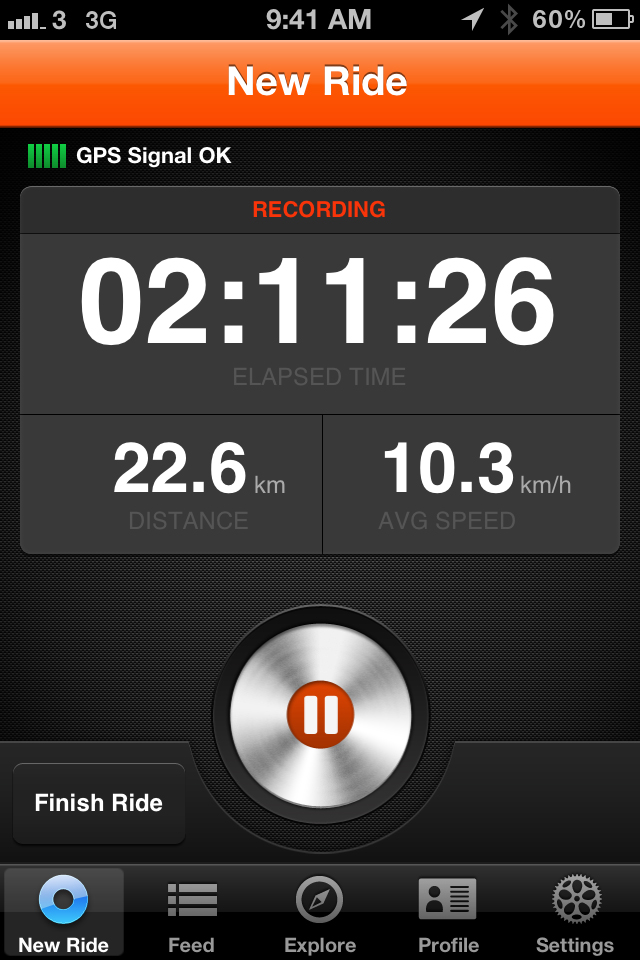Think you just railed that downhill section or nailed that climb like a World Champ? Want the proof so your mates don’t call bullshit?
The cost of owning a cycling-specific device can be hard to justify, but many of us already own an easily modifiable substitute product: the smart phone. There are many apps available for iPhone (and Android) that claim to replace the old bike computer, heart rate monitor and even the newer GPS unit – but are these apps any good for mountain biking?[private]
We tested five popular iPhone apps to see what they offer and how they compare: MapMyRide, Strava Cycling, MountainBikePro, Garmin Fit and iBiker. (Sorry Android users, your day will come soon.)
The low-down on bike computer apps
Some cycle computer apps are designed to track your fitness progression, some show you where to ride and others are designed to help you compare your awesomeness to others. The apps tested share many tracking features: speed, distance, elevation, and post-ride route-mapping and ride history, to name a few.
The information-gathering capacity of these apps can be expanded with aftermarket sensors and receivers to gauge heart rate and cadence.
Seeing as all the tested apps make use of your phone’s GPS for live tracking, they do chew through battery life. We had up to as 50% battery burn in just 2.5 hours of use.
Where you put the phone is the hardest part and possibly the biggest downside compared to a cycle-specific unit. There are bike-specific phone cases, but the phone’s large size doesn’t lend well to on-bike mounting for off-road use, and it’s not easily accessible while in your pack.
MapMyRide (Free)
This is a popular app and has a growing community of users, which means there’s a great deal of ride information available for download.
Users can find cycle routes within their locality, and rides of specified distances. When you ride these routes, live tracking can help you stay on track. This feature exists for both road and MTB riding, and it’s a neat feature if you’re unsure of where to go.
MapMyRide is one of the more comprehensive apps available. It also offers a complete food tracker and training history for those on a mission.

Strava Cycling (Free)
Racing your mates and pushing your own limits online – Strava has certainly become a popular (if painful) form of social networking.
Strava takes your total ride and breaks it into segments. So, your regular loop might consist of a popular climb and a popular descent. With this app, you’ll be able to compare your times in these sections against others by just turning on the app.
While more for those with a competitive edge, Strava Cycling does give you the ability to see where you stand, performance-wise, and that alone can motivate improvement.
The functionality is great. It has an easy to use layout and has useful features such as the elevation and speed graphs to look at post-ride.
MountainBikePro ($6.49)
This is the only mountain bike-specific app on test, and it’s jam-packed full of features.
All the apps we tested trace your movements via GPS and, because the mapping is done through cellular data, if reception is poor, your app’s mapping service will be too. To get around that, MountainBikePro includes an offline mapping feature for those rides where no phone signal has gone before.
While this feature is dependant on you downloading the map before you lose connection, it is a useful function if you’re about to ride in an unknown area. The offline maps are in topographic format and offer enough detail to find the nearest main trail or way out.
MountainBikePro also provides seriously in-depth detail, ranging from the weather info, a compass and total ascent stats to altitude. The layout is clear and in an easy to use, too. Just watch that battery life if you’re planning an epic.
Garmin Fit ($0.99)
Made by Garmin, the market leaders in cycle-specific GPS units, the Garmin Fit app has many useful features.
iTunes connectivity within the app and to wireless transmitters is available. (Garmin even sells its own iPhone ANT+ connector.)
There’s a function to lock the screen while still keeping the app visible at a lower brightness level – perfect for conserving battery life if you want to be able to see your phone while you’re riding.
Garmin Fit makes for a great training app and allows users to upload their data to Garmin’s online training database, Garmin Connect.
Simple to use, the Garmin Fit app did not chew through the battery life as quickly as the other apps on test.
iBiker (Free)
Don’t be fooled by the name. iBiker is not a mountain bike-specific app; it’s more a fitness tracker.
The iBiker has a calorie tracker and connection to iTunes, and makes for a pretty neat heart rate monitor when paired to the appropriate sensors. This app can be used for running, hiking, indoor spin classes and cycling.
But if you’re serious about getting fit and want one app to take to every form of workout, iBiker is well worth your consideration.
[/private]



